Eye On Apparel: Seeing Green
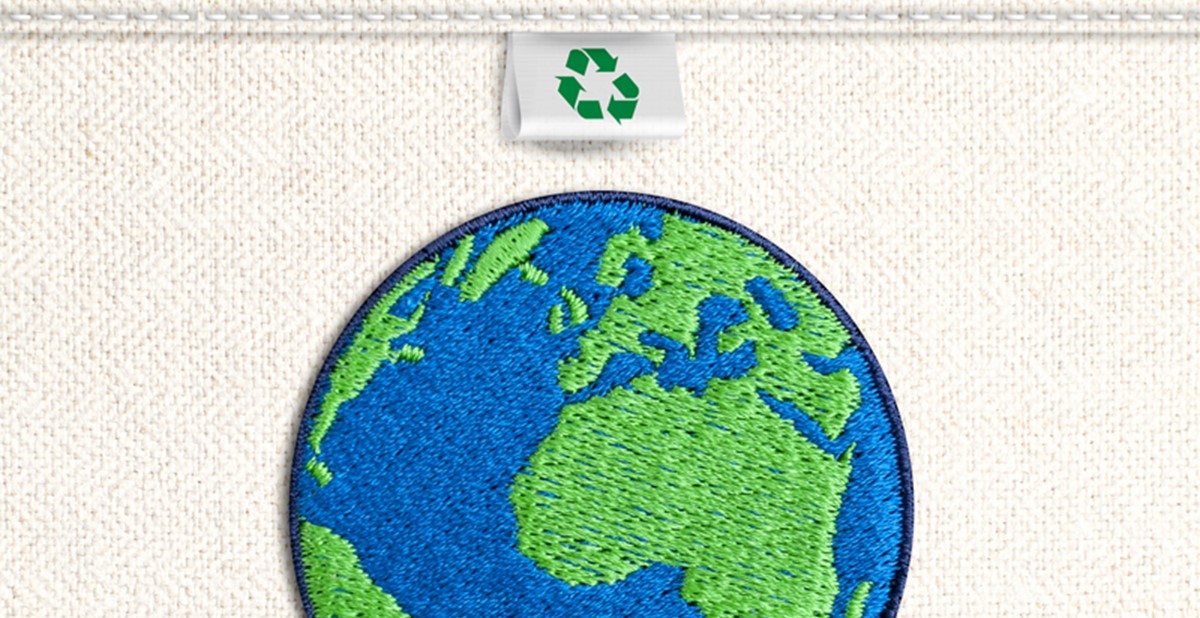
Sustainability is more than a buzzword in the fashion industry this year; it’s become an action that consumers expect from the brands they engage with. With consumers still fatigued over the widespread effects of 2020, they are seeking more from the brands to which they give their business. This year, we can expect to see a greater call for brands to join the movement toward a greener, cleaner environment, and demonstrate how they are contributing to the well-being of their stakeholders, from workers to consumers and communities, writes Good On You, a brand rating system founded in Australia that assesses fashion brands according to people, planet and profit. For example, when end users receive a branded shirt made from eco-friendly fabrication, the garment becomes a way for them to represent the brand, but also to proudly show support for, and be associated with, what the brand stands for.
The sustainability of an apparel company is, in part, measured by the fabric that is sourced and its cultivation, and the manufacturing processes used to produce the finished garment, along with the effects of these manufacturing processes on the environment. Many companies are tackling all sides of this issue. Patagonia has emerged as a leader in sustainability for its environmental advocacy and efforts to reduce waste. Last year, the outdoor clothing company announced that 68 percent of its products were made from recycled materials, such as plastic bottles—which salvaged enough energy to power 2,300 homes for a full year. The company also operates a Worn Wear program, allowing customers to buy new apparel made exclusively from recycled clothing, and to also recycle their used Patagonia gear for a discount on future purchases. It also maintains its Patagonia Action Works program, a digital tool that connects customers to local events, petitions and opportunities to volunteer for environmental causes. Not only is Patagonia moving toward greener practices internally, but it’s extending opportunities outward to encourage end user involvement.
No longer can brands simply sell products; consumers expect them to take action on bettering society. A majority of consumers worldwide say they are concerned with sustainability today, according to a study published last year by IBM Institute for Business Value and the National Retail Federation. In surveying 18,980 consumers across 28 countries, including the U.S., nearly eight in 10 respondents said they feel it is at least moderately important for brands to offer clean products (78 percent), for brands to be sustainable and eco-responsible (77 percent), and for them to support recycling (76 percent) and use natural ingredients (72 percent). And more than three-fourths of those (77 percent) who felt these factors were important were also willing to pay 35 percent more for sustainable products, showing that companies’ efforts toward greener practices may also generate more revenue.
Sustainability in fashion is not only important for brands’ reputation, but it’s reached a level of critical concern for the ecosystem, further compelling businesses—and those who buy from them—to step in and get involved. Brand recycling programs are critical, as according to Environmental Protection Agency, household clothing and textiles comprise 5.8 percent of all municipal solid waste in the U.S. each year; the equivalent of 70 pounds of clothing discarded per person annually, or a total of 5,600 pounds over the course of their lifetime, according to Council for Textile Recycling—and of which 95 percent is recyclable. (To put this into perspective, that’s equivalent to 3,920 sets of underwear, 3,920 pairs of socks and 2,800 t-shirts.) But aside from starting with the end, as recycling follows a garment’s production, sustainability also begins at the root with the materials used to make the fabric. Brands looking to show their support for the environment can opt for branded apparel made from sustainable fabrics, such as 100-percent cotton. In the U.S., cotton farmers are actively working toward more sustainable solutions, and over the past 40 years, according to the National Cotton Council of America, U.S. farmers have reduced the amount of land needed to produce cotton crops by half, and also decreased water and energy usage by more than half, lowered greenhouse gases by 40 percent and reduced soil erosion by 35 percent. Cotton is also more closely regulated, as cottonseed is used in animal feed and human food products, such as cottonseed oil—which is used in salad and cooking oils, and in margarine and shortening—and is thus recognized as a food crop. And, just as important,100-percent cotton clothing is known for being super soft, breathable and highly customizable.
Many consumers are vested in sustainability and consider it a personal priority, which may be due in part, according to Business Insider, to social signaling. Social signaling, writes Business Insider, supports that consumers make certain buying decisions because of what their purchases tell others about them. It’s the same reason why consumers purchase designer bags: not only do they like the look of the bag, but they also like the social status associated with owning a high-end bag. Bearing this motivation in mind, consumers who purchase or wear sustainable goods may do so, at least somewhat, because it gives them a way to make a difference while also conveying their awareness, involvement and support of the cause to those around them.
Selecting wearables with an eco-friendlier backstory to showcase your client’s logo or messaging allows end users to proudly represent the brand and also the causes the brand represents. Read on for wearables made from eco-friendly fabrics and processes to feature in your client’s next project or promotion.
–––––––––––––––––––––––––––––––––––––––––––––––––––––––––––
The news that Hanes’ Beefy-T Crewneck Short-Sleeve T-Shirt is now being made with 100-percent U.S.-grown cotton came with the supplier’s new initiative to raise awareness about apparel sustainability and quality in the promotional products industry—and it's a great product for carrying forward this message. Ultra-soft with a roomier fit, the tee features a lay-flat collar and non-chafe fabric taping to help keep its shape as it’s worn again and again. Available in 38 colors in S-3XL and in a complementary children’s size, shown in clean mint. 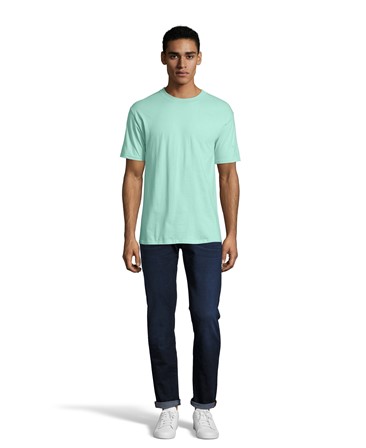
Hanes / PPAI 191138, S10 / www.haneslocator.com
–––––––––––––––––––––––––––––––––––––––––––––––––––––––––––
The Kootenay Crewneck is an easy-wear, unisex pullover made from a blend of 80-percent cotton and 20-percent polyester brushed back fleece. But what’s really special about this made-in-Canada item is that 70 percent of the raw materials used to make this sweatshirt are sourced within a 100-mile radius of the supplier’s factory. The garment, which is prewashed and preshrunk, features flat-lock stitching for added durability and one-by-one-inch rib cuffs and a waistband. Available in XS-3X in 14 colors, shown in purple sand. 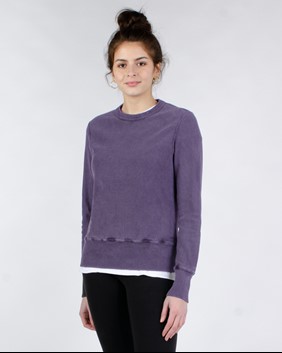
Redwood Classics Apparel / PPAI 696010, IS / www.redwoodclassics.net
–––––––––––––––––––––––––––––––––––––––––––––––––––––––––––
The Planet Polo is made from an eco-friendly tri-blend of 45-percent recycled polyester, 45-percent polyester and 10-percent elastane, but what’s even more interesting is that each shirt prevents seven plastic bottles from winding up in the earth’s oceans and landfills. It’s also moisture-wicking and features a self-goods collar with a collar band and a three-button snap placket. Available in women’s XS-3XL and men’s S-5XL in rainforest, onyx, beach, ocean, orange, cobalt, silver and red sky (shown).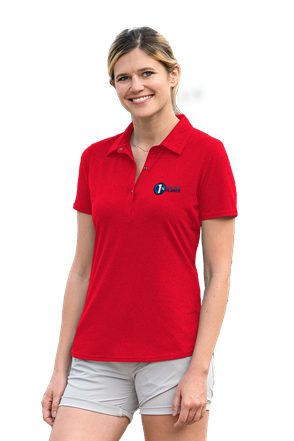
Vantage Apparel / PPAI 113235, S10 / www.vantageapparel.com
–––––––––––––––––––––––––––––––––––––––––––––––––––––––––––
The Vansport Trek Hoodie is impressive, to say the least—each hoodie helps prevent 12 discarded plastic bottles from polluting the environment. Made from a tri-blend of 45-percent-recycled polyester, 45-percent polyester and 10-percent elastane, this five-ounce heather jersey is also moisture-wicking, and features self-goods cuffs and a kangaroo pocket. Available in men’s S-5XL and women’s XS-3XL in eight colors, shown in orange, with a variety of customization options available. 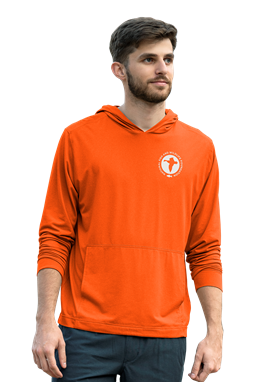
Vantage Apparel / PPAI 113235, S10 / www.vantageapparel.com
–––––––––––––––––––––––––––––––––––––––––––––––––––––––––––
A snug-fitting choice for greener headwear, the Atlantis Headwear Pure Sustainable Knit is made from a blend of 60-percent recycled polyester, which includes polymers sourced from discarded plastic bottles, and 40-percent acrylic. The 13-inch cuffed knit beanie is made with Polyana® yarn, which has a wool hand, and is also OEKO-TEX®-certified; an international testing system to ensure the responsible use of chemicals in all stages of product production. Available in one-size-fits-most in seven colors, shown in mustard yellow.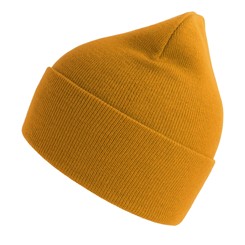
Kati Sportcap / PPAI 113758, S5 / www.katisportcap.com
–––––––––––––––––––––––––––––––––––––––––––––––––––––––––––
A timeless cap made for all seasons, the YP Classics Ecowash™ Dad Hat is made from 100-percent cotton, and features an unstructured, six-panel, low-profile build. It’s made through an EcoWash process that uses less water and energy, and zero chemicals. The EcoWash twill cap also features a Permacurv® visor and tri-glide buckle closure with a 3.125-inch crown. Available in one-size-fits-most in six colors, shown in navy. 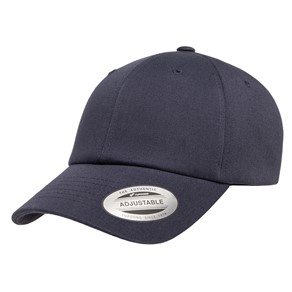
Kati Sportcap / PPAI 113758, S5 / www.katisportcap.com
–––––––––––––––––––––––––––––––––––––––––––––––––––––––––––
J. America’s new Flip Side Collection introduces two styles, a crew (pictured center) and a hoodie, made from a tri-blend of 55-percent cotton and 45-percent polyester, inside-out fleece. The Flip Side Fleece Crew and the Flip Side Fleece Hood are super soft, light to midweight fleece. The crew features a one-by-one-inch rib contrast collar, and the hoodie has one-by-one-inch contrast cuffs and waistband. Both feature a contrast twill tape at the back of the neck, double-needle stitching throughout and a tearaway label. Available in XS-3XL in charcoal heather (left), chambray heather (center) and grey heather (right).
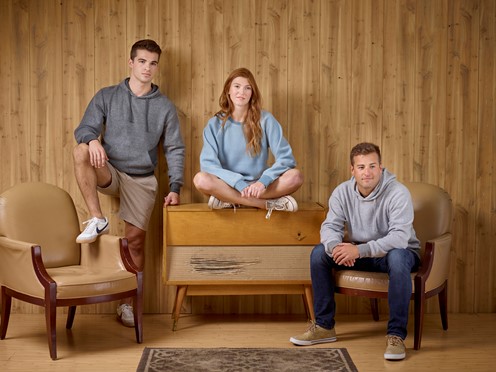
J. America Blanks / PPAI 351699, S1 / www.jamerica.com
–––––––––––––––––––––––––––––––––––––––––––––––––––––––––––
Not only is this puffer jacket fully insulated, but it’s made with quilted Polyloft® insulation—recycled polyester sourced from post-industrial waste fibers, which is just as easy to wash as it is to wear. The midweight, 100-percent nylon classic fit jacket includes details such as angled chest stitching, chin-guard fasteners and pull-cord hemlocks, along with zippered side pockets, shoulder set sleeves and side vertical panels. Available in S-4XL in black, carbon, charcoal/red, deepwater/orange, navy/electric blue and russet/navy (shown).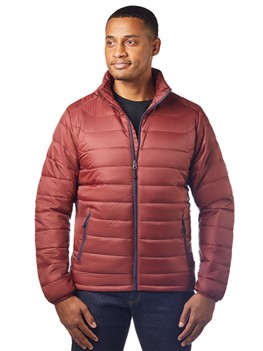
Landway International Corp. / PPAI 243349, S1 / www.landway.com
–––––––––––––––––––––––––––––––––––––––––––––––––––––––––––
An item that’s not only super soft, but also makes a lasting impact, the Unisex EcoSmart® ComfortBlend® Full-Zip Hood Sweatshirt with Pocket is made from a blend of 50-percent cotton and 50-percent polyester—with slight variations for different colors—of which up to five percent of the polyester is derived from recycled plastics. This midweight, fleece sweatshirt is part of Hanes’ EcoSmart family of products, which helps prevent 50 million discarded plastic bottles from entering landfills each year. Details include ribbed cuffs and waistband, roomy front pockets and a dyed-to-match drawcord. Available in S-3XL in 15 colors, shown in maroon.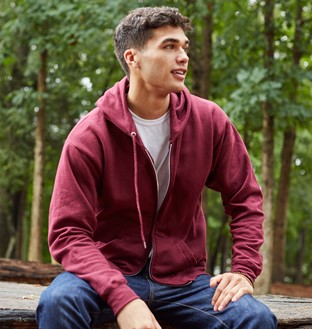
Hanes / PPAI 191138, S10 / www.haneslocator.com
–––––––––––––––––––––––––––––––––––––––––––––––––––––––––––
Not only is the Women’s Custom-Dyed Signature Crew available in any color imaginable on the color wheel—talk about perfect logo matching—but it’s also eco-friendly. Made in the USA from a blend of 50-percent Supima cotton and 50-percent micromodal, which is derived from recycled beechwood—the company’s signature fabric blend—it’s also pre-washed and pre-shrunk to ensure a perfect fit. Available in SX-XL.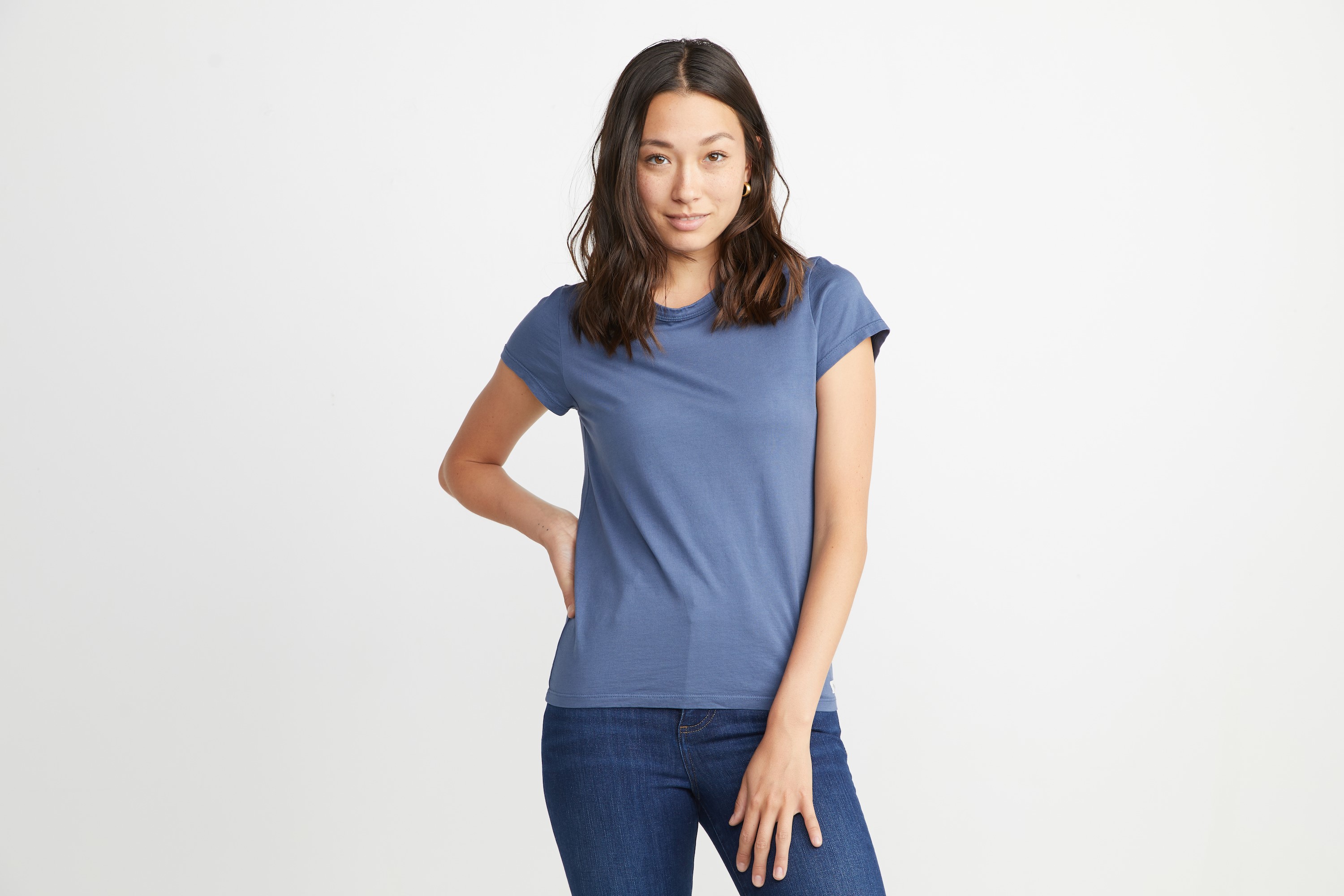
Marine Layer, Inc. / PPAI 690355, S1 / www.marinelayer.com
–––––––––––––––––––––––––––––––––––––––––––––––––––––––––––
Promised to be ridiculously soft, the lightweight Afternoon Hoodie is a classic sweatshirt made from eco-friendly materials. Pre-washed and pre-shrunk, its fabrication features Marine Layer’s signature blend of 50-percent Supima cotton and 50-percent micromodal, the latter of which is derived from modal, a raw material sourced from beechwood. Made in the USA in XS-2XL in faded navy, asphalt gray and black (shown).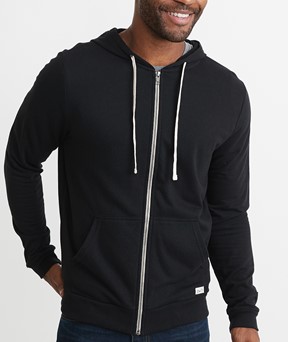
Marine Layer, Inc. / PPAI 690355, S1 / www.marinelayer.com
–––––––––––––––––––––––––––––––––––––––––––––––––––––––––––
The elegant, flattering kimono by Knotty Tie Co. offers a way to beautifully showcase branding that’s sure to turn heads. With full-color sublimation available, there’s no limit on customization. The 43-inch-long kimonos are made from recycled polyester chiffon and feature a decorative edge. To boot, each kimono is made in Denver, Colorado, by skilled, resettled refugees. 
Knotty Tie Co. / PPAI 720849, S1 / www.promoknottytie.com
–––––––––––––––––––––––––––––––––––––––––––––––––––––––––––
With hundreds of unique colors and prints to choose from, these bow ties look sharp and are easy on the environment. The bow ties, and all of Knotty Tie’s products, are made in small batches from sustainable fabrics, and are individually wrapped using recycled paper packaging. Contributing to a larger social mission, the products are also USA-made and are hand-sewn in Denver by refugees. Choose from dozens of eclectic designs under the categories of animals, art deco, dogs, dots, floral, food and drink, geometric, nautical, ornate, paisley, plaid, retro, space, sports, states, stripes, textured and “with friends.”
Knotty Tie Co. / PPAI 720849, S1 / www.promoknottytie.com
–––––––––––––––––––––––––––––––––––––––––––––––––––––––––––
Recipients are sure to comment on the unique construction of the Taurus, a vegan-friendly, all-natural paper fanny pack that’s not only water-repellent, but it’s washable as well. A fully on-brand way to convey support for eco-friendly initiatives, the fanny pack is made from cellulose plant fiber paper, which is both lightweight and durable, resists tearing and washes like fabric. With a weathered look and feel, the fanny pack is also 100-percent biodegradable, and will begin decomposing within two weeks of being planted—yes, planted—in the ground. Even better, part of the proceeds is donated to Project Aware, which works to clean the world’s oceans.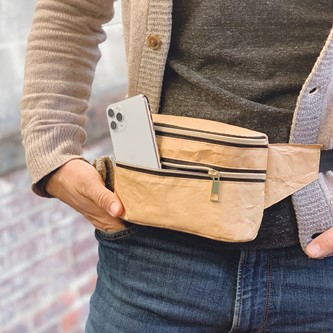
Gordon Sinclair / PPAI 111537, S4 / www.gordonsinclair.com
–––––––––––––––––––––––––––––––––––––––––––––––––––––––––––
Danielle Renda is associate editor of PPB.

